When PSG Féminine announced last summer that they had acquired the services of Barcelona Femení winger Lieke Martens, there were many who felt that it was a signing of intent and that the Netherlands star could be the one to take the French club to the next level, both domestically and in Europe. As one writer commented previously, she is “one of the most complete technical players in women’s football”, and yet, at the Spanish giants, she didn’t often get the recognition that her performances merited during her five years with them.
Martens has tended to play in a free-roaming role at Barcelona, with her often seen on both sides of the pitch and in central areas too, and that was one reason that she was such a good fit for their style of play. At PSG, things have been a little more structured, which some might have thought would hinder Martens’ creativity and would potentially hold her back.
However, the reality has been quite the opposite, with the Dutch forward adapting well to her new surroundings and making adjustments to her game that have enabled her to deliver what head coach Gérard Prêcheur has asked of her.
This tactical analysis will look at those tactical alterations, highlighting what has changed in Martens’ game and why they have yet to phase her. The scout report will also show how Netherlands head coach Andries Jonker has taken note of those changes and how he has started to implement them into his own tactics, with regard to Martens’ role in the national side, ahead of the World Cup this summer.
Barcelona Femení
Before looking at her performances in Paris this season, the analysis will begin by setting out the basic aspects of her role at Barcelona last season, providing a series of comparison points to build the remainder of the breakdown on.

The keyword associated with Barcelona last season was rotations (and, to an extent, it still is). However, whilst many people will instantly recall those made by Jennifer Hermoso, Alexia Putellas and Aitana Bonmatí, there were other examples of positional changes on show, with the wide forwards and full-backs constantly working together to create problems for opponents in the wide areas, with one drifting infield whilst the other held the width.
This was more noticeable on the right of the field, with Marta Torrejón a little more attack-minded than now-Manchester City Women defender Leila Ouahabi, but that doesn’t mean that Martens and Ouahabi didn’t link up. Here, for example, the latter has the ball on the wing but has been closed down by Atlético Madrid Femenino right-back Sheila García, meaning that she is unable to advance any further up the pitch.
This is where Martens comes in, with her identifying the gap that has been left open in the defensive line and running forward at pace to exploit it, with midfielder Maitane López unable to keep up with her and therefore allowing the Dutch international to receive the ball inside the field and keep the ball alive. Having this intelligence and knowing when and where to move forward is a key aspect of Martens’ game, and is one of the things that Barcelona relied on her for throughout her five years in Spain.

Another reason that she was such an important player for them was that she was a winger who tended to stay in advanced areas of the field and play on the shoulder of opposing defensive lines, which provided the rest of the team with a permanent target player whenever they needed to make rapid counterattacks or wanted to play more directly.
The fact that she received the ball in these areas meant that Martens was generally given time to control the ball and look to drive infield, due to the opponents not being in a position when she received the ball to close her down. This situation shows the danger that that posed, with only Real Betis Féminas defender Vicky Benítez in a position to stop Martens from taking the ball into the central areas.
However, with Martens being a very good 1-v-1 player and always being capable of changing direction on the spot, these were generally never close contests, and, even though she ended up missing the target with her eventual shot on goal, the fact that she scored 12 times and assisted seven other efforts in all competitions in 2021/22 demonstrates that there weren’t many occasions when she let her opponents off in these areas of the field.
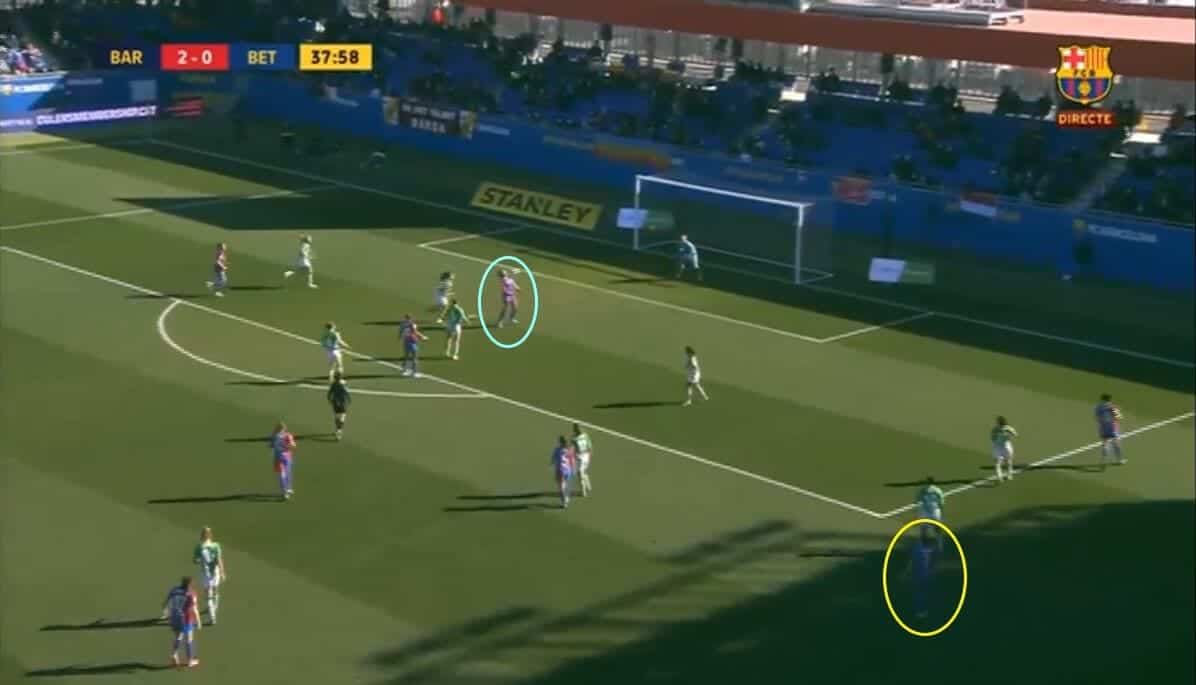
The fact that she possessed that goal threat was one of the main reasons that Barcelona head coach Jonatan Giráldez and his predecessor Lluís Cortés afforded her so much positional flexibility, with them recognising that allowing her to take up different positions during games would cause headaches for the opposing side.
Therefore, it was not uncommon to see her getting into the middle and over to the right at times, constantly switching to where she felt that she could have an effect on the game. In this case, she has recognised that Norway forward Caroline Graham Hansen is looking to deliver a cross into the middle from the near side of the pitch and that there is no one available to receive the cross, so she has moved forward to take up that role and test Switzerland goalkeeper Gaëlle Thalmann’s resolve.
Again, whilst this chance doesn’t find the back of the net, there were plenty of others that she did score from these positions during her time in Liga F, so her attacking threat cannot be underestimated.
PSG Féminine
It was clear, therefore, that PSG were signing a player who was at her best when allowed to move around and play as high up the field as possible, and many expected her to continue that at her new club. However, they had other ideas, and have instead adjusted her game tactically as they have tried to blend her individual qualities with Prêcheur’s favoured tactics.
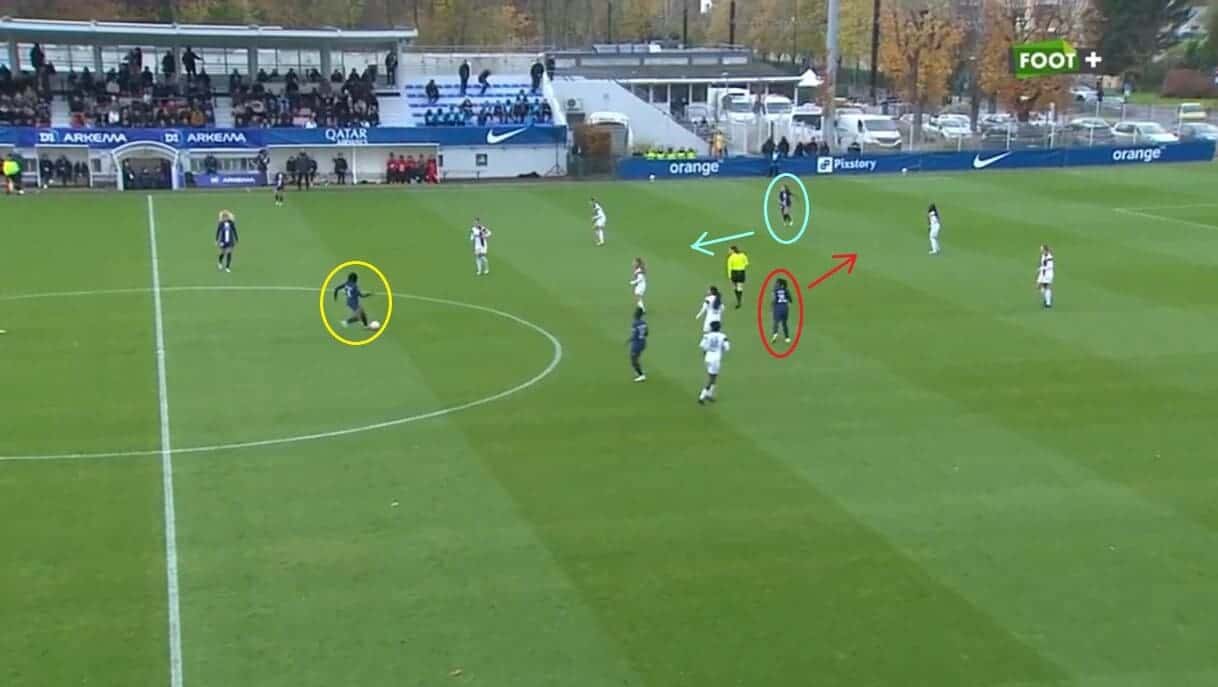
These have not been drastic changes, it should be noted, and mainly revolve around what she does off the ball rather than on it. In this case, she is in a similar position to how she played at Barcelona, with her on the shoulder of the Guingamp Féminines defensive line, but, instead of running behind them, as she would have done for Barcelona, she instead moves towards the ball. This is because PSG like their forwards to be involved in building chances as they look to play a series of shorter passes in transitions, and so Martens has needed to drop back in order to fit into this style of play.
This has led to the Dutch winger often becoming a creator rather than a finisher in France, with her moving into deeper areas and then turning to feed the ball into the path of one of her teammates. However, whilst it is different to last season, the fact that her passing accuracy for this season currently stands at an impressive 82%, compared to 78.8% for the entirety of last season, shows that it is something that she has taken to well.
In this case, once the ball has arrived at her feet from Oriane Jean-François, she turns and feeds it into the path of Magnaba Folquet, who has run forward to replace her in the final third, with deadly precision, and that shows how, even though she has a different role to play this season, it is still giving her just as much importance in her new side’s attacking play.
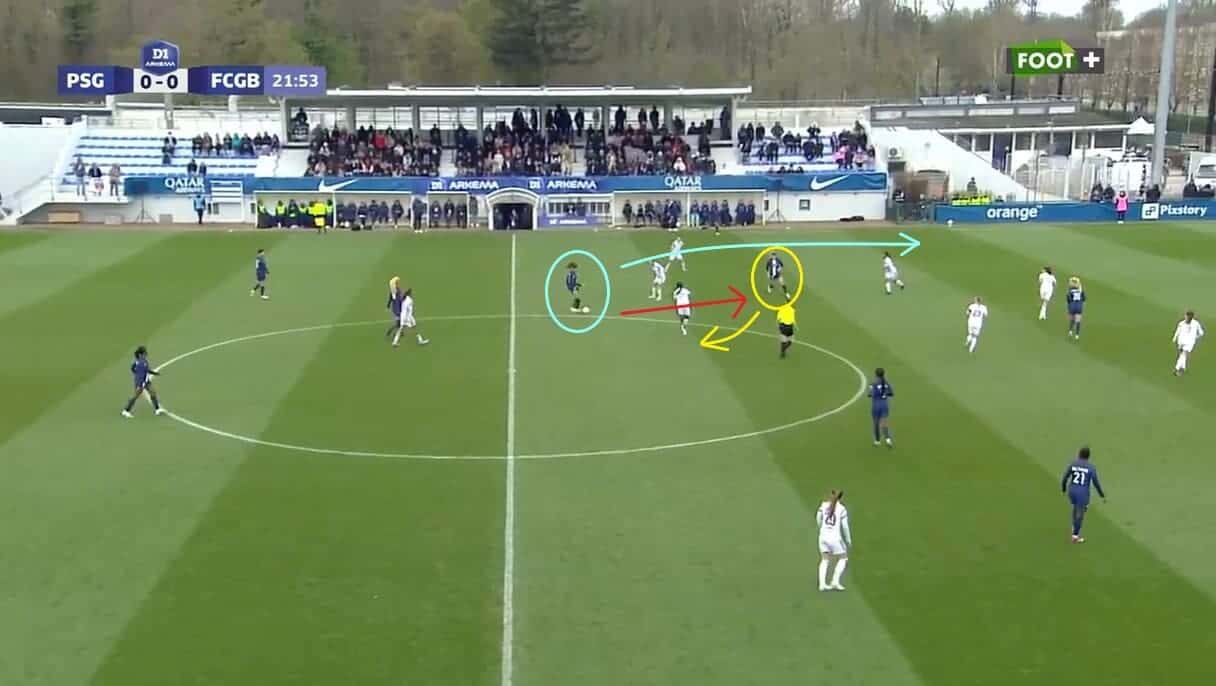
Being able to play with this level of quality has allowed PSG to introduce their own rotations this season, although they are not the same as Martens was used to at Barcelona. Instead, she has needed to get used to more vertical switches, with her now not being required to move between the half-spaces and wide roles and instead altering between dropping deep and moving into advanced spaces.
In this case, she has received the ball just inside Bordeaux Féminines’ half and has noticed both the positioning of American midfielder Korbin Albert and the space behind Bordeaux’s defensive line, and this is all the invitation that she needs to instigate one of these rotations.
Having identified the area that she wants to attack, she sends the ball towards Albert and then makes a curved run into the gap that Bordeaux have left open, with Albert reading what she is looking to do and dropping back to take her place once she makes her run, before then turning and passing back towards the Dutch forward to complete the move.
Again, these are not what Martens was used to, but she has taken to them well, and it is another reason that she has become an effective player for PSG and someone that they have been able to rely on as the campaign has progressed.
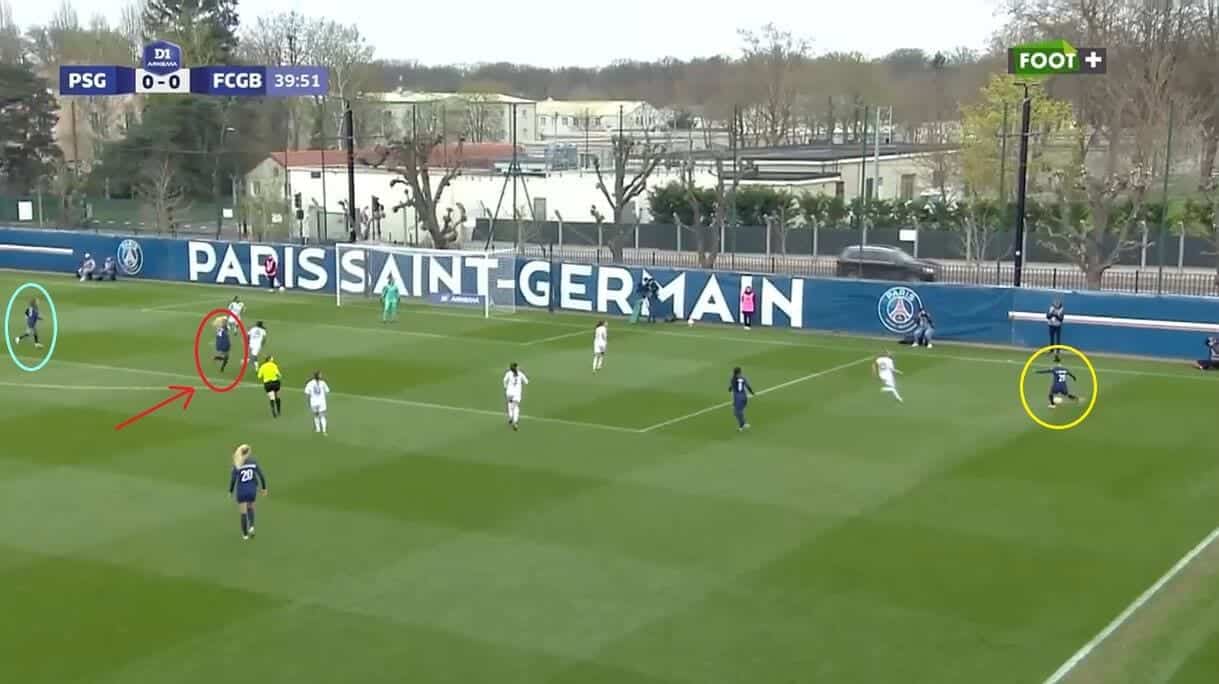
It is not only the rotations that Martens has been required to adjust to though, with her also needing to be more structurally disciplined and to not cut inside into central spaces whenever they open up.
Instead, she has been asked to stay wide and allow others to make those runs, with Kheira Hamraoui, also once of Barcelona, moving forward once Denmark attacker Amalie Vangsgaard, who joined in January from Swedish club Linköpings, has dropped back and been taken out of the game.
Martens’ role here is to provide the “backstop”, ensuring that, should the cross from China right-back Li Mengwen, who is on loan from Jiangsu Ladies, overshoot its intended target, PSG can keep the chance alive. When considering this, it is no surprise that her offensive duels won per game and touches in the penalty area are both down this season compared to the last one, with them standing at 33.3% compared to 47.2% and 6.49 compared to 7.29 respectively.
However, there is another reason that Prêcheur has asked Martens to not get too central in these situations because he wants to prevent the opposition from being allowed to move closer together and set up compactly, as that will make it harder for PSG to have a sight of goal. In this case, by forcing Bordeaux to stay apart from each other, PSG have a chance to find the back of the net, and it is clear that Martens has taken to this idea just as well.
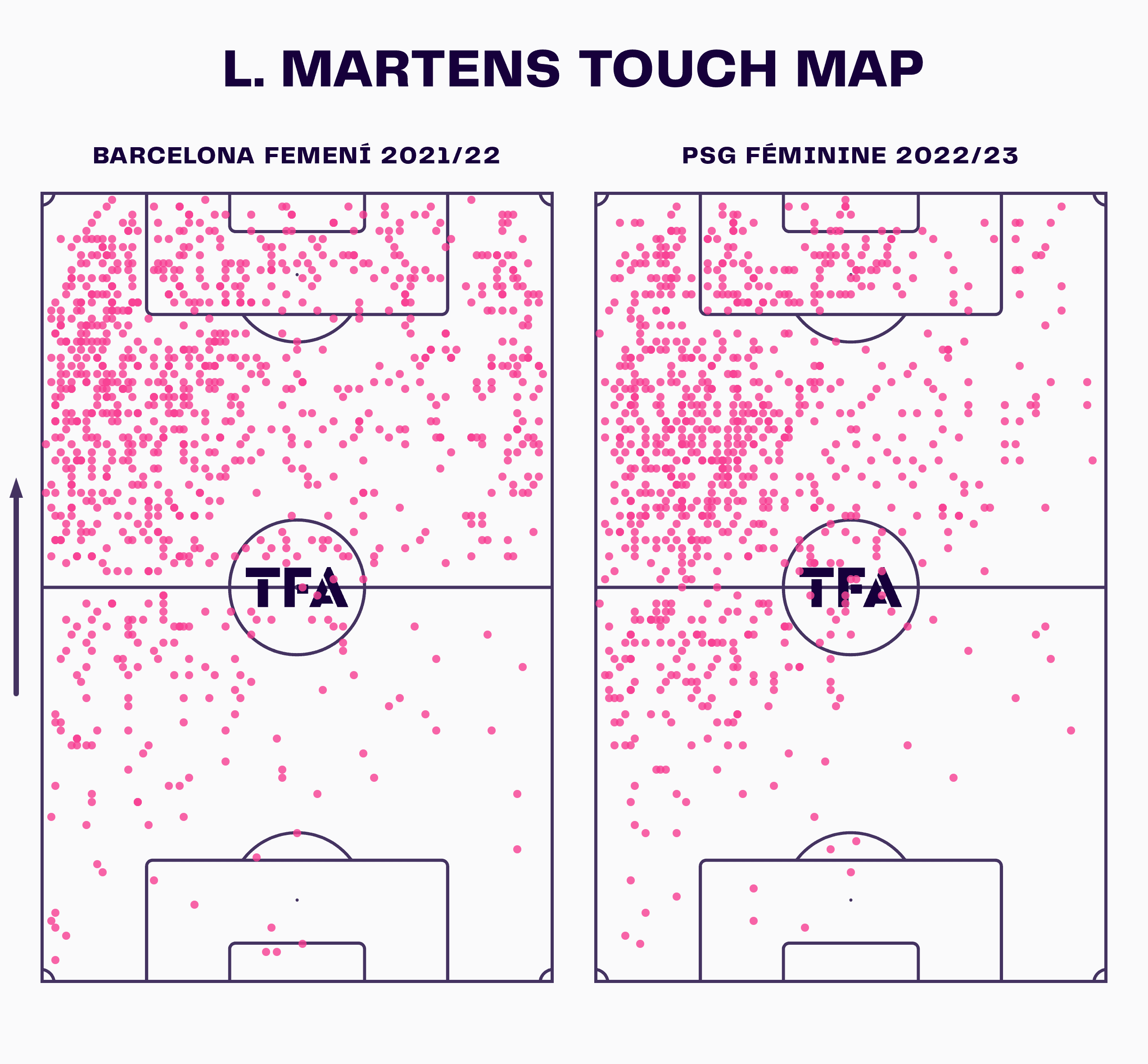
However, the point still remains that she is now operating in a different way during games, with this graphic indicating the different areas of the field that she has had touches of the ball in, both for Barcelona last season and for PSG in the ongoing one.
Immediately, it is clear in the right-sided map that there are more touches on the right of the pitch and fewer inside Barcelona’s own half, and that provides a clear indication of how Martens has not been able to play across the field as much as she did previously and has instead needed to stay in her own channel and play more vertically, and, with this in mind, it is of no surprise that, to date, she has only found the net on four occasions this season and has yet to assist a goal.
However, the fact that she has adjusted to this style of play so well shows how intelligent she is, and being able to deliver what is required of her is one of the main reasons that PSG have come to view her as someone that they can rely on.
Netherlands
The fact that Lieke Martens can now play in different ways has seemingly caught the attention of Netherlands head coach Andries Jonker, who replaced Mark Parsons last summer after their disappointing Euro 2022 result.
During his first two games in charge, a friendly double header against Austria, it was clear that he wanted Martens to play as a key target player but to also drop into deeper areas of the field too, mixing the best of what she has shown during her time at both Barcelona and PSG.

That fusion has taken time to produce results, and initially, it didn’t work out as hoped. However, this was not down to Martens and was instead due to the overall team structure not giving her what she needed to play that way.
To explain, the Netherlands set up in both games against Austria with a 4-2-3-1 formation, using 29-goal Eredivisie Vrouwen top scorer Fenna Kalma in the central striker role in the first game and then Juventus Femminile’s Lineth Beerensteyn in the second. Martens played as the left winger in both games but was often seen drifting into the 10 role, as is the case here.
However, whilst there were no issues with Martens’ ability to get into the central areas, there was an issue in the way that Austria were able to limit her threat, with them using the fact that there was only one striker to sit back and stay between the ball and goal. By doing so, Irene Furhmann’s side allowed Martens to get on the ball but never gave her a clear view of goal. As a result, whenever she got into these spaces, she nearly always squandered the opportunity.
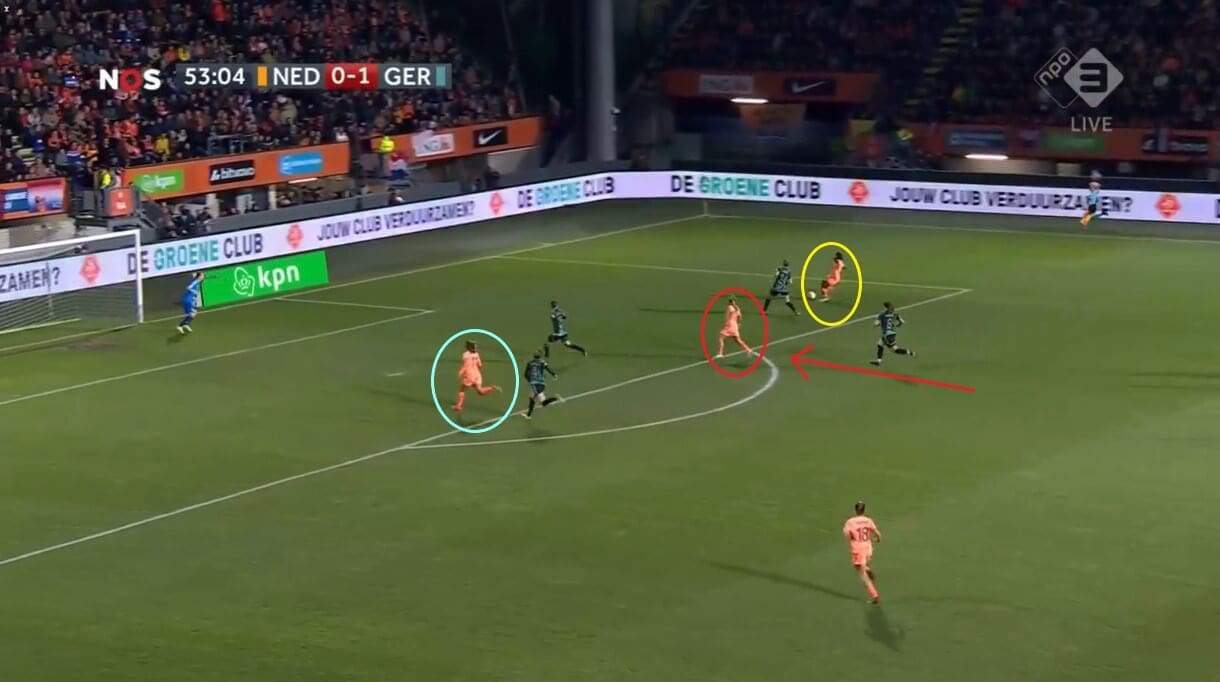
Despite those initial teething problems, there was clearly something there that Jonker could build on, and it was a tactical idea worth persevering with. What needed to change was that the Netherlands needed to find a way of manipulating the opposing defensive line into spreading out, and Jonker did that by tweaking his system and introducing the concept of wing-backs, with them in use during both of their most recent matches against Germany and Poland.
However, that was only half the story, because Jonker also paired Beerensteyn and Martens in a front two, moving away from having one attacker at the top of the field, and that also made a big difference to their play.
The key thing is that neither of them are out-and-out strikers and are instead more wide forwards who possess a goal threat, which meant that they would naturally drift towards the half-spaces in order to get on the ball in areas where they were more comfortable. That then took the defenders away from each other as they followed the two forwards, meaning that there were spaces in the middle for the Netherlands to exploit.
That is where the former Arsenal Women duo of Daniëlle van de Donk and Jill Roord, who lined up as eights in this setup, were brought into the game, with both being creative attacking players who like to get among the goals for Lyon Féminin and Wolfsburg Frauen respectively.
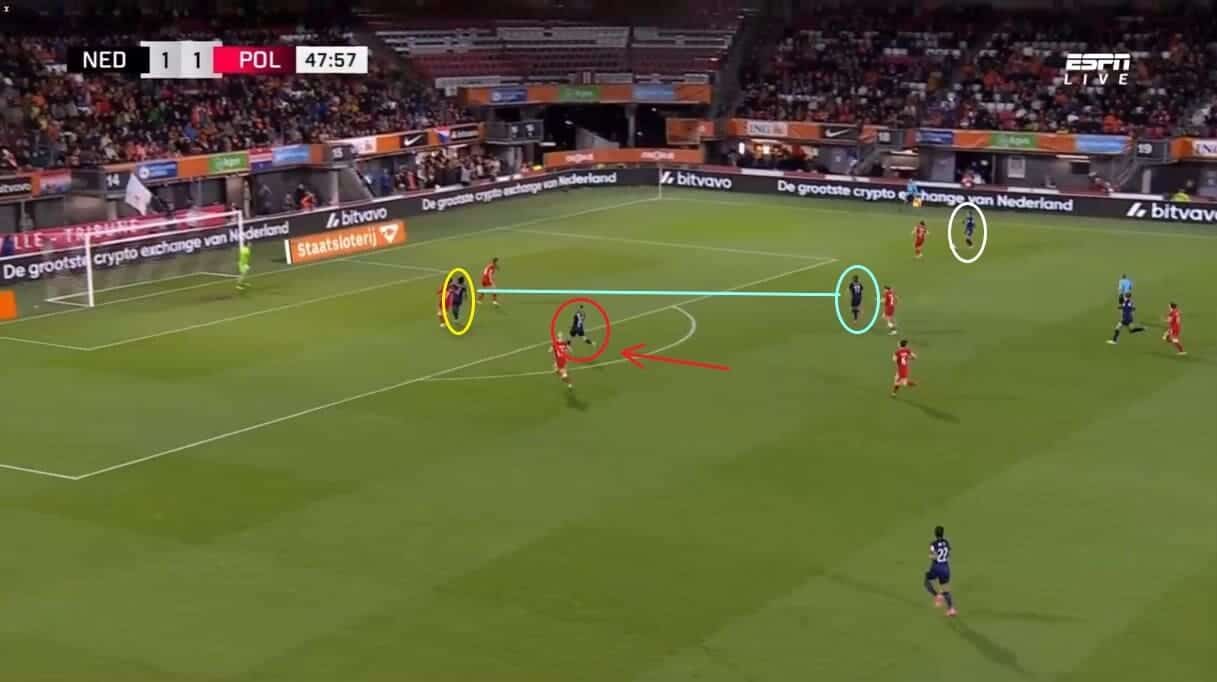
This system would also allow Martens to drop back into the 10 role but to have more success in it, with the addition of extra numbers in the middle and wing-backs on either side of the field (roles that were taken in both of these games by Arsenal’s Victoria Pelova and PSV Vrouwen’s Esmee Brugts) making it impossible for the German and Polish defences to stay compact. Instead, as Poland have shown here, they were forced to move out and allow the Netherlands to play through them.
The key thing was that, with this new formation, Martens was able to demonstrate the positional versatility that Jonker had noticed in her club performances, with her now in a position to get into the same central areas as a 10 but to then have the gaps ahead of her to shoot at goal through.
This was what had been missing when implementing this tactic in their previous games, and the fact that the Netherlands won this match 4-1, with Martens getting her name on the scoreboard, showed that this tweak had the desired effect for Jonker as well as allowing the PSG player to demonstrate why she is considered to be “one of the most complete technical players in women’s football”.
Conclusion
In conclusion, this tactical analysis has looked in greater detail at the role played by Lieke Martens for PSG Féminine this season, comparing it to her time at Barcelona Femení and indicating how she has needed to adapt this season to fit into the tactical ideas that new head coach Gérard Prêcheur has looked to implement.
Martens has always been one of those players that has gone under the radar during her career, with her often overshadowed by other star names such as Putellas or, when with the national team, Vivianne Miedema. However, there is little doubt that she is a very clever player who does a lot more on the field than some give her credit for, and PSG are fortunate to have her in their squad. With their fans not having many star names to enjoy watching at this point in time, this could finally be her time to step into the spotlight and become a crowd favourite.
Her departure from Barcelona was not exactly smooth, with accusations circulated of her agreeing a contract extension and then not signing it and ignoring club officials towards the end of the season, and that will have lost her some fans in Spain. However, if she continues to play at this level during her time in the French capital, then she could well replace those with some new ones. It is clear that the squad hold her in high regard, and the hope among everyone connected with the club is that, given her calibre, experience and quality, she will be the one to lead them to future success.





Comments